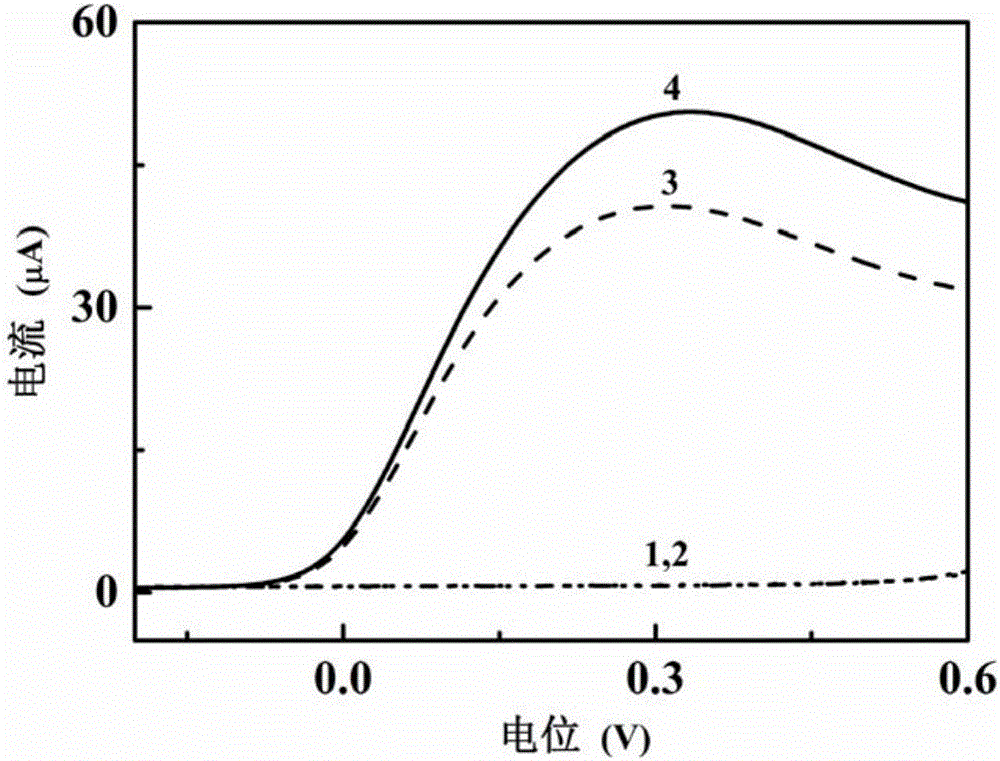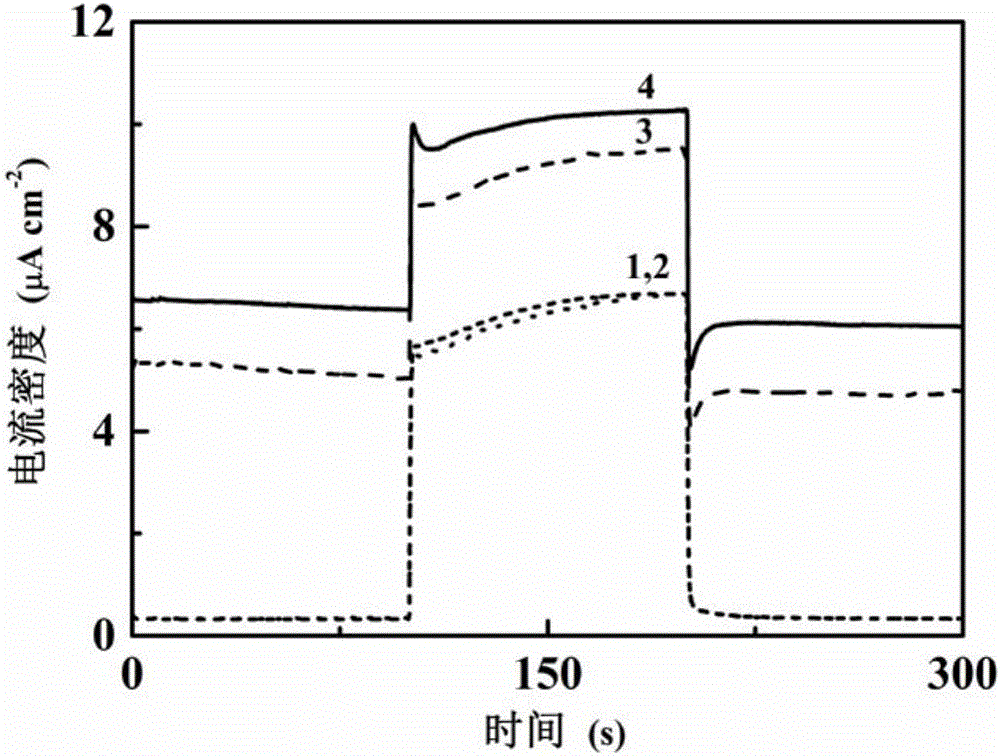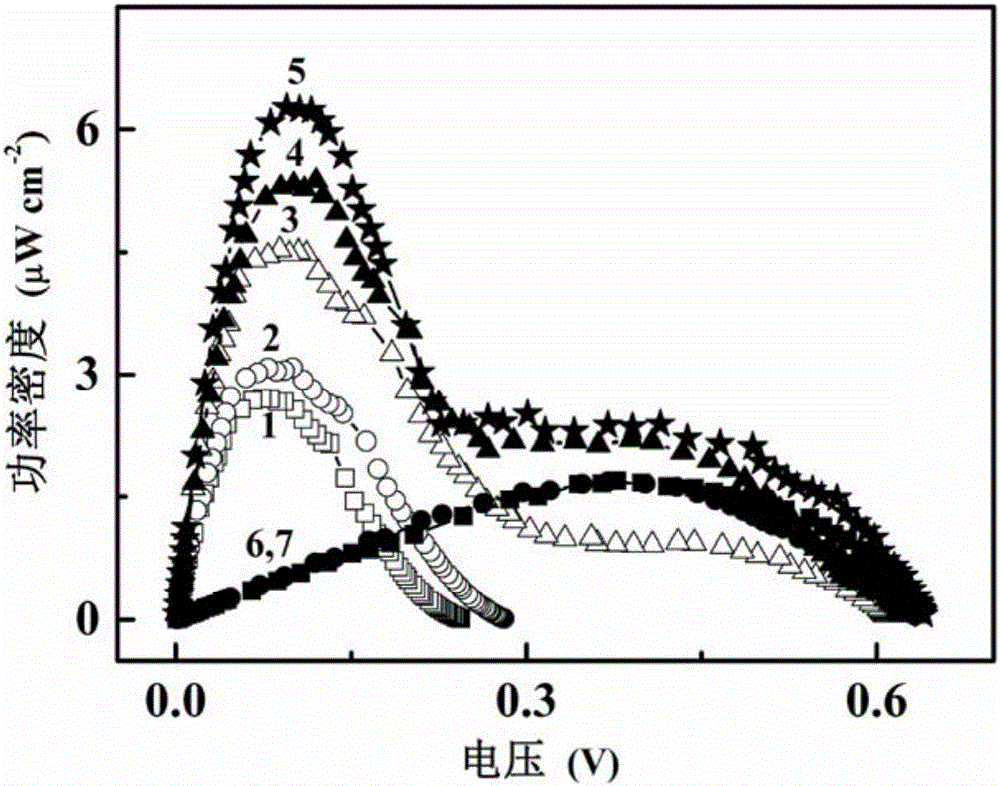Bovine-serum-albumin-reinforced ascorbic acid/glucose fuel cell and application thereof
A technology of bovine serum albumin and ascorbic acid, which is applied in the field of photocatalytic fuel cells, can solve the problems of decreased electrode activity, difficult electron and material transport, etc., and achieves the effects of simple production, good biocompatibility and high photocatalytic activity
- Summary
- Abstract
- Description
- Claims
- Application Information
AI Technical Summary
Problems solved by technology
Method used
Image
Examples
Embodiment 1
[0028] Example 1 Construction of Ultraviolet Light Excited Bovine Serum Albumin Enhanced Ascorbic Acid / Glucose Fuel Cell
[0029] The bovine serum albumin sensitization CdS / TiO of the present embodiment 2 The electrode is prepared by the following method:
[0030] (1) Immerse the indium tin oxide conductive glass (ITO) into the prepared ethanol-dispersed TiO 2 (After calcination treatment at 450°C) the solution was pulled three times to make the solution adhere to the substrate. After taking it out, put the electrode in an oven at 40°C and dry it for 12 hours to obtain TiO 2 Electrodes were stored in a dark box.
[0031] (2) Using cyclic voltammetry electrodeposition method, the working electrode is TiO 2 electrode, the counter electrode is a titanium plate electrode, and the reference electrode is a saturated calomel electrode to form a three-electrode system. The electrolyte is a pH 2.0 solution containing 0.01mol / L cadmium chloride and 0.01mol / L sodium thiosulfate. The ...
Embodiment 2
[0035] Embodiment 2 ascorbic acid and ascorbic acid promote the electrocatalytic oxidation of glucose
[0036] The bovine serum albumin sensitization CdS / TiO that prepares in embodiment 1 2 The electrode performs linear voltammetry scanning in ascorbic acid and ascorbic acid / glucose, and the specific operation steps are as follows:
[0037] Bovine serum albumin sensitized CdS / TiO made with embodiment 1 2 The electrode was used as the working electrode, the titanium electrode was used as the counter electrode, and the saturated calomel electrode was used as the reference electrode. A three-electrode system was constructed and connected to an electrochemical workstation, and the linear voltammetry scanning method was used to measure the concentration in buffer solution (1) and glucose (2) respectively. , current in ascorbic acid (3) and glucose / ascorbic acid (4) versus potential ( figure 1 ), to elucidate bovine serum albumin-sensitized CdS / TiO 2 Electrode ascorbic acid and a...
Embodiment 3
[0039] Example 3 Ultraviolet Light Enhanced Photocatalytic Oxidation of Ascorbic Acid / Glucose
[0040] The photoelectrochemical fuel cell built in Example 1 is tested, and the specific steps are as follows:
[0041] Connect the anode and cathode of the photoelectrochemical fuel cell with a resistance box, the resistance of the fixed resistance box is 10,000 ohms, and the switch lights are controlled at equal time intervals, and the current density of the photoelectrochemical fuel cell is measured and calculated ( figure 2 ) curves over time.
[0042] What is shown in curve 1 is that in the buffer solution, no current signal appears in the dark, but under ultraviolet light irradiation, an obvious photocurrent appears, with a value of 6.72 μA cm -2 ; Then after adding glucose, curve 2 shows that there is no current signal in the dark, but the photocurrent under ultraviolet light radiation is 6.73μA·cm -2 , almost unchanged compared to curve 1, indicating that glucose alone is...
PUM
| Property | Measurement | Unit |
|---|---|---|
| Maximum power | aaaaa | aaaaa |
| Short circuit current | aaaaa | aaaaa |
| Concentration | aaaaa | aaaaa |
Abstract
Description
Claims
Application Information
 Login to View More
Login to View More - R&D
- Intellectual Property
- Life Sciences
- Materials
- Tech Scout
- Unparalleled Data Quality
- Higher Quality Content
- 60% Fewer Hallucinations
Browse by: Latest US Patents, China's latest patents, Technical Efficacy Thesaurus, Application Domain, Technology Topic, Popular Technical Reports.
© 2025 PatSnap. All rights reserved.Legal|Privacy policy|Modern Slavery Act Transparency Statement|Sitemap|About US| Contact US: help@patsnap.com



